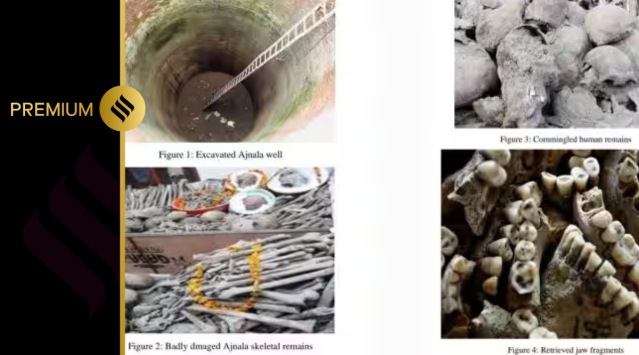New research backs old proof: Ajnala skeletons are of Indian soldiers killed in 1857 revolt
Chemical signatures identity method reveals that the human remains found in Ajnala well belong to UP, Bihar, West Bengal and coastal Odisha.
 The fresh scientific evidence is part of research that has been published in the International Journal of Legal Medicine.
The fresh scientific evidence is part of research that has been published in the International Journal of Legal Medicine. The nearly-250 human skeletons found dumped in an abandoned well in the Ajnala town of Punjab’s Amritsar in 2014 were of Indian soldiers killed during the uprising of 1857 and not of those murdered during the Partition in 1947, fresh scientific evidence has suggested. The strontium isotope analysis, endorsing the previous DNA-based genetic evidence, also suggested that the remains were of people who were from Gangetic plains — Uttar Pradesh, Bihar, West Bengal — and coastal Odisha and not of those living in and around Ajnala.
The fresh scientific evidence is part of research that has been published in the International Journal of Legal Medicine. The research was jointly carried out by Chandigarh-based Panjab University, Lucknow’s Birbal Sahni Institute of Palaeosciences, and Canada’s Memorial University.
Quoting the historical records, Dr JS Sehrawat, a forensic anthropologist from Panjab University, said as many as 282 Indian soldiers were killed and thrown in the well in 1857 and a small religious structure was later constructed there. In 2014, during a non scientific excavation, skeletal remains of 246 individuals were recovered from the well. The same year, the government tasked a group led by Sehrawat to scientifically investigate the matter.
Sehrawat says the historical records suggested that the slain victims belonged to 26th Native Bengal Infantry Battalion in which people from eastern UP, West Bengal, Bihar and coastal Odisha used to be recruited. But some historians, according to the researchers, believe that the skeletons are of locals who were killed during the communal clashes during the Partition. To determine the genetic origin of the remains, 50 samples were subjected to mitochondrial DNA (mtDNA) analysis. In addition, 85 several samples were subjected to oxygen isotope analysis — the latter sheds light on food habits.
“When we eat or drink something, it leaves chemical signatures in our teeth and in bones. These chemical signatures, based on food habits, can tell us about the place where a person lived. The samples from the recovered skeletons were matched with the samples of water, food grains and rocks from the areas concerned,” said Sehrawat.
The samples were examined at the laboratory of Canada’s Memorial University.
“The results from the new research are consistent with the genetic evidence of DNA study that the slain victims of 26th Native Bengal Infantry Battalion came from the Gangetic plains and endorse the molecular forensic results published in the journal Frontiers in Genetics in 2022,” he added.
Niraj Rai, an expert on ancient DNA and a co-author from Lucknow’s Birbal Sahni Institute of Palaeosciences, said: “The published results are based on first time ever use of stable isotopes in mass scale forensic identification in the country and are expected to provide baseline data for future forensic provenance studies that will contribute to the global efforts of mapping Sr isotope variations”.
The researchers used strontium isotope ratios obtained from 27 teeth samples and the findings supported that the human skeletons found in the well were not of people living in and around Ajnala. Rather, strontium isotope abundances matched with the water sources, cereals and rock samples from Gangetic plains. “Strontium isotope analysis results revealed that the individuals, whose skeletons were found in the well, did not live in the Amritsar region during their childhood and that they came from the Gangetic plain regions,” Sehrawat added.
As per the historical records, Sehrawat said, soldiers from 26th Native Bengal Infantry Battalion posted at Mian-Meer cantonment (nowadays in Pakistan), killed British officers in a revolt. “They were captured by the British army near Ajnala on banks of river Ravi and executed,” he said.
He added: “The present study findings would prove a landmark/reference for future provenance studies aimed at estimating geolocation of unknown human remains based on strontium isotope analysis in Indian context. It will add a significant chapter in the history of the unsung heroes of India’s first freedom struggle”.
Niraj Rai said that scientific research done by this team helps look at the historical events from evidence-based scientific perspective.








